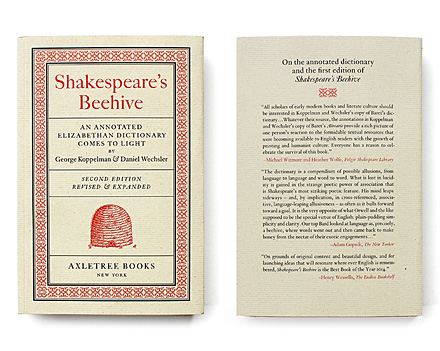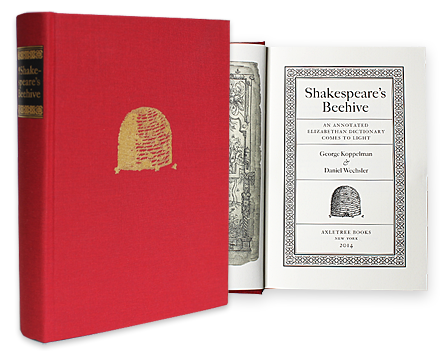Beehive Blog
Authors George Koppelman and Daniel Wechsler report on new discoveries and selectively respond to what others have written in the media
June 6, 2014
Baret’s Alvearie: The Biblical Annotations
In our study, Shakespeare’s Beehive: An Annotated Elizabethan Dictionary Comes to Light, we reference twelve biblical annotations as among the most significant of the spoken annotations for several reasons, none more critical than the fact that they have all been born out of the annotator’s memory and do not appear printed in Baret. In comparing the English Bible translations of the period, we observe that, without exception, whenever a translation differs, our annotator’s biblical citations are closer to the Great Bible translation (1540) and the Bishops’ … Read More
Why the Interest in the Yew Tree?
One of the words that captured the greatest amount of attention, and possibly even the imagination, of the annotator of the Baret is the “Yew” tree. In our study, we interpreted three of the annotations that are penned beside the variant spellings as “IHS” monograms, entered to imply the association with Christ and the wood used for the cross. In the first posted reply to the Folger’s Michael Witmore and Heather Wolfe’s piece, “ Buzz or honey? Shakespeare’s Beehive raises questions ,” Erin Blake correctly notes that the French word “If” means “Yew” … Read More
May 1, 2014
Bucke-basquet, Bucket baquet, both, or neither?
Among the most heavily discussed and analyzed annotations in our copy of Baret during the first week of unveiling have been two words that appear side-by-side on the trailing blank. The busy bees responsible for bringing to the public’s attention a possible misreading are Aaron Pratt and Eve Siebert , each of whom has written a piece dissecting our transcription and our understanding of the annotations. We thank them for having taken the time to look so carefully at the annotated dictionary in question, but feel it is necessary to … Read More
The Poet’s Hand
By my life, this is my lady’s hand these be her very C’s, her U’s and her T’s and thus makes she her great P’s. It is, in contempt of question, her hand. – Twelfth Night [II, 5] Malvolio Voices from Adam Gopnik to Jonathan Bate have not been shy in publicly asserting that the hand in the Baret does not match the poet’s hand; the poet, of course, being Shakespeare. We feel it is important to clarify what components of the “poet’s hand” are being referenced. Of all the books … Read More
Welcome to the Shakespeare’s Beehive Blog
The last chapter in our book , “My Darling” (followed by an Afterword, a citing of sources, and concluding notes), ends with the bold assertion that, when it comes to our Baret, “we are confident that it is capable of yielding a great deal more.” Of course, we must admit, that there will also, on occasion, be less. Possible misreadings of annotations, and our own enthusiasm for commonplace word pairings, will be strongly emphasized by those who disagree with our conclusion, as well as by those who may … Read More
For Beehive Blog updates, follow us on Facebook and Twitter.



